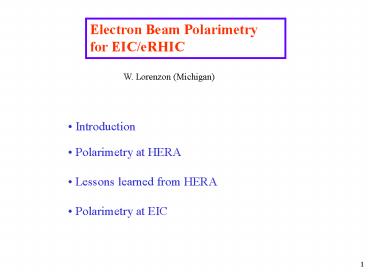Longitudinal Polarimeter at HERA - PowerPoint PPT Presentation
Title:
Longitudinal Polarimeter at HERA
Description:
Title: Longitudinal Polarimeter at HERA Subject: EIC talk Author: Lorenzon Last modified by: Wolfgang Lorenzon Created Date: 6/24/2001 7:44:04 AM Document ... – PowerPoint PPT presentation
Number of Views:87
Avg rating:3.0/5.0
Title: Longitudinal Polarimeter at HERA
1
Electron Beam Polarimetry for EIC/eRHIC
W. Lorenzon (Michigan)
- Introduction
- Polarimetry at HERA
- Lessons learned from HERA
- Polarimetry at EIC
2
EIC/eRHIC
3
How to measure Polarization of e-, e beams?
Macroscopic polarized electron bunch very week dipole (10-7 of magnetized iron of same size) Microscopic spin-dependent scattering processes simplest g elastic processes cross section large simple kinematic properties physics quite well understood three different targets used currently 1. e- - nucleus Mott scattering 100 - 300 keV 2. e? - electrons Møller (Bhabha) Scat. MeV - GeV 3. e ? - photons Compton Scattering gt GeV
4
Other Labs employing Electron Polarimeters
Many polarimeters are or have been in use
Compton Polarimeters LEP mainly used as machine tool for resonant depolarization DESY HERA, storage ring 27.5 GeV (two polarimeters) Jlab Hall A lt 8 GeV Bates South Hall Ring lt 1 GeV Nikhef AmPS, storage ring lt 1 GeV Møller / Bhabha Polarimeters Bates linear accelerator lt 1 GeV Mainz Mainz Microtron MAMI lt 1 GeV Jlab Hall A, B, C
5
Electron Polarization at HERA
Self polarization of electrons by Synchrotron radiation emission in curved sections Sokolov-Ternov effect (t 30 min.)
6
Principle of the Pe Measurement with the
Longitudinal Polarimeter
Eg
l (2.33 eV)
e (27.5 GeV)
a
Calorimeter
back scattered Compton photon
Compton Scattering el g e? Cross Section
ds/dEg ds0/dEg1 PePlAz(Eg) ds0, Az known
(QED) Pe longitudinal polarization
of e beam Pl circular
polarization (?1) of laser beam
532 nm laser light
EIC
HERA
Compton edge
7
Compton Polarimetry
Detecting the g at 0 angle Detecting the e- with an energy loss Strong ? good energy resolution for photons Photon energy cutoff Time need for a measurement Small crossing angle needed non-invasive measurement
HERA
EIC
Jlab
Asymmetry
Very good polarimetry at high energy or/and high currents (storage rings)
8
Compton Polarimetry at HERA
Operating Modes and Principles
Laser Compton scattering off HERA electrons TPOL LPOL CW Laser Single Photon Pulsing Laser Multi Photon Flip laser helicity and measure scattered photons Py0.59 Pz0.59 Spatial Asymmetry Rate or energy Asymmetry Statistical Error DP1 per minute _at_ HERA average currents
9
Experimental Setup Laser System
- M1/2 M3/4 M5/6 phase-compensated mirrors - laser light polarization measured continuously in box 2
10
Experimental Setup - Details
11
Systematic Uncertainties
Source DPe/Pe () (2000) DPe/Pe () (gt2003)
Analyzing Power Ap - response function - single to multi photon transition Ap long-term stability Gain mismatching Laser light polarization Pockels Cell misalignment Electron beam instability - 1.2a (0.9) (0.8) - 0.5 - 0.3b - 0.2 - 0.4b - 0.8b - 0.8 (-0.2) (-0.8) - 0.5 -0.2 -0.2 -0.2 -0.3
Total -1.6 -1.0
anew sampling calorimeter built and tested at DESY and CERN bstatistics limited expected precision (multi-photon mode)
12
Polarization-2000
HERMES, H1, ZEUS and Machine Group Goal Fast and precise polarization measurements of each electron bunch Task major upgrade to Transverse Polarimeter (done) upgrade laser system for Longitudinal Polarimeter (in progress) (courtesy F. Zomer)
Fabry-Perot laser cavity (dPe)stat 1/min/bunch
Final Cavity
Mount for travel
13
Polarization after Lumi Upgrade
All three spin rotators turned on Pe gt 50
14
Lessons learned from HERA
Include polarization diagnostics and monitoring in design of beam lattice more crucial for ring option than for linac option measure beam polarization continuously ? minimize systematic errors Two (three?) options to measure polarization Compton Scattering ( 5 GeV) Longitudinal Polarization rate or energy asymmetries (? 30) Transverse Polarization spatial asymmetries (? 50mm) Møller Scattering (100 MeV many GeV) under investigation depolarization (? I2) due to beam RF interaction with the e- spins Consider three components laser (transport) system conventional transport system laser accessible at all times, robust, radiation damage to mirrors, proven technology optical cavity laser not accessible at all times, expensive, delicate, ring operation ? laser-electron interaction region minimize bremsstrahlung and synchrotron radiation introduce a chicane optimize Compton rate small crossing angle Compton detector radiation hard, fast (lt35ns) Cerenkov detectors superior to scintillation detectors record energy and position of individual Compton events
15
EIC Collider Layout
V. Ptitsyn (BNL), A-C D
- Proposed by BINP and Bates
- e-ring is ¼ of RHIC ring length
- Collisions in one interaction point
- Collision e energies 5-10 GeV
- Injection linac 2-5 GeV
- Lattice based on superbend magnets
- polarization time 4-16 minutes
- Conventional magnets (Sokolov-Ternov)
- polarization time 10-320 minutes
- 25-250 GeV protons,
- 100 GeV/u Au ions (79)
16
Polarimetry at EIC
Ring - Ring Option measure beam polarization continuously -gt minimize systematic errors (1) Compton Scattering (5-10 GeV) Longitudinal Polarization Transverse Polarization -gt two independent measurements with vastly different systematic uncertainties Laser (transport) system either conventional transport system or optical cavity -gt wait for experience at HERA (both systems available) Laser-electron interaction region introduce a chicane to minimize bremsstrahlung and synchrotron radiation Compton detector needs to be radiation hard and fast (lt35ns) record energy and position of individual Compton events -gt operate in single or few photon mode -gt monitor linearity of detector brems edge, Compton edge, asymmetry zero crossing detect scattered electron and photon in coincidence -gt suppress background Include Electron Beam Polarimetry in Lattice Design































